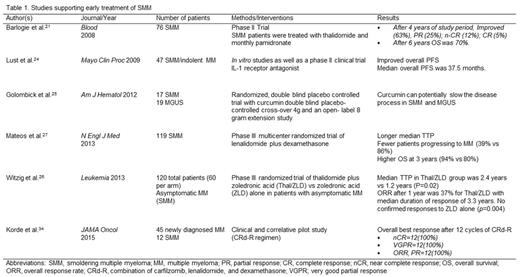Abstract
Introduction: The IMWG defined smoldering multiple myeloma (SMM) as presence of 10-60% plasma cells in bone marrow and M-protein (IgG, IgA) ≥3 g/dL without end organ damage (increased calcium level, renal failure, anemia, destructive bone lesions). Patients considered to have SMM should not have any myeloma defining events or amyloidosis. Risks factors classify SMM into low, intermediate, or high risk categories. Rate of progression from SMM to symptomatic myeloma is ~10% per year during the first 5 years of diagnosis. SMM requires frequent follow up, ~ every 3 months during the first 5 years compared to monoclonal gammopathy of undermined significance (MGUS) which requires follow-up every 6 to 12 months. This review presents literature and available data that support or do not support early treatment of high risk SMM and provides evidence-based recommendations for SMM management.
Materials and Methods: A literature search was performed using electronic bibliographic databases: MEDLINE (Ovid SP and PubMed), EMBASE, The Cochrane Library (Cochrane Database of Systematic Reviews (CDSR), and Cochrane Central Register of Controlled Trials (CENTRAL), as well as annual meetings abstracts from inception till May 2017. The literature search focused mainly on randomized clinical trials, phase II/III, and retrospective studies. Different search terms like Smoldering Multiple Myeloma, Smoldering Myeloma, early treatment. and asymptomatic myeloma treatment were used to find the relevant material for this review article.We selected 51 articles from the literature search.
Discussion: Experts in the field of myeloma have differing opinions about the management of SMM. There is growing number of data (summarized in attached table ) that provides some rationale for the early treatment of high risk SMM, supported by the logic that it has a very high rate of conversion to myeloma and, therefore, it is in the best interest of the patient to control the disease before it causes end organ damage. Early treatment of high risk SMM carries the risk of development of resistance to current therapies. There are other concerns like toxicities of currently available therapies, questionable long term effectiveness of current therapies, and cost of therapies for SMM.Patients with SMM are asymptomatic and have a good quality of life in general; therefore, subjecting an asymptomatic patient to medication related side effects and potentially impairing their quality of life should be taken into consideration before recommending treatment for high risk SMM. There is also considerable concern for patient compliance and clinical follow up, especially with parenteral therapy. Oral therapy potentially should solve this issue.
Conclusion: Based on current literature review and current practices, SMM should be managed with close follow up at 3 to 6 months interval and outside a clinical trial, treatment should only be initiated if patient develops active MM or myeloma defining events(MDE), because of the risk of developing resistance to current myeloma therapies, cost, treatment related toxicities, and psychological implications for patients and their families. With more sensitive imaging such as MRI and 18F-FDG PET/CT, many patients who were previously considered high risk SMM were actual cases of myeloma meeting the IMGW 2014 criteria. SMM is a spectrum, bridging MGUS on one extreme and multiple myeloma on the other. We foresee that this entity (SMM) will disappear in the near future with the use of better diagnostic criteria, utilizing sensitive radiological testing and incorporating molecular profile based on genomics of plasma cell disorders. Patients will be either MGUS, not needing any treatment or multiple myeloma, requiring therapy.
No relevant conflicts of interest to declare.
Author notes
Asterisk with author names denotes non-ASH members.


This feature is available to Subscribers Only
Sign In or Create an Account Close Modal